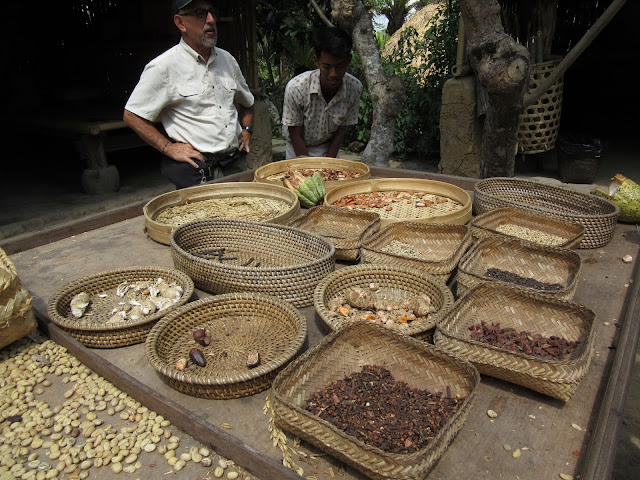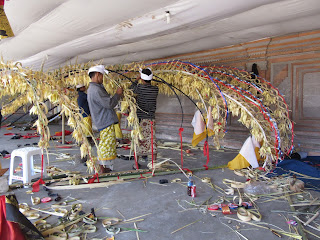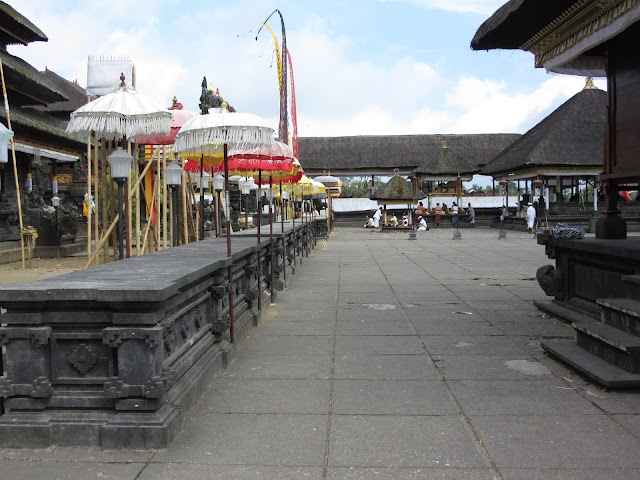Wi, our driver from Be Balinese Tours, was picking us up in Ubud at 8:30 again ready to start another day in beautiful Bali. Today we were visiting the northeast region of Bali .
 |
| We needed a breakfast fit for a king to sustain us all day as we knew we wouldn't be stopping for food en route! |
 |
| Town's entrance statue/sculpture! |
There were no taxis or certainly no public transportation in sight, or tourists either for that matter.
When I asked Wi how tourists could come here, he said that
people can just wave down cars and see if they’re going where they want to go.
Sounds logical enough but I was confounded by the practicalities, i.e. how to
communicate in a foreign language, how to know where the driver is going, how
much to pay, etc!
It was interesting to see that there was no discernible end
of the city of Ubud and then the
beginning of Tegallang as everything seemed to run together. Shortly after Tegallang, Wi stopped so we could walk among some terraced rice fields that you see in many parts of Bali.
Photos from our walk through the rice fields:
All tourists wanting to just drive pass through the rice field area have to pay 10K rp each as each field is owned by a separate family. We were surprised there were virtually no workers toiling in the fields so Wi told us it was because they’re only needed at this point to check on water levels, remove trash, etc. It was fun climbing and walking through the rice terraces. |
 |
Wi pointed out
that the scarecrow is used in the fields
to drive away snakes and also birds.
|
 |
| Rice here was just planted 3 weeks ago, according to Wi. As an occasional rice farmer too, Wi was sure to know. |
Steven and I really enjoyed our walk through these rice fields as you could probably tell from just some of the photos I took while there! Then back in the car for two minutes where we stopped at Bali Pulina Agro,
a large coffee and cocoa plantation set up for tours.
Photos from Bali Pulina Agro:
The large wooden bell at the entrance is struck when there is news of an
impending earthquake.

 |
| Post poo shell and slimy feeling bean! |
 |
 |
A huge cocoa pod. And yes, it did smell like chocolate!
|
 |
| The cleaned and dried coffee beans are roasted here before being ground. We saw it being done with a mortar and pestle but I am sure that was only for demonstration purposes. |
 |
| Grain of red rice grown in Bali, one of 4 types also grown here. |
 |
| The demonstration spice table: almost every spice you can think of was represented here. We had been lucky that Sandy had shown us so many of these spices growing during the 20 minute tour. |
 |
| Vanilla pod. |
 |
| My favorite was the cinnamon whose fragrant scent could be detected in both the bark and leaf above. |
Then we were served 10 mini cups of a variety of teas and
coffees to sample for free in a striking location overlooking the fields. What a way to relax. Ended the fascinating tour in the souvenir shop of course!
Back in the car headed toward the 11th C. Pura
Titru Empul, known as the Holy Water
Temple village
of Mas
 |
| First Balinese script we'd seen. I had no idea that the script would also be different from other languages spoken in |
 |
 |
| The immense Jack fruit. |
 |
| Another temple and therefore more temple rules. |
 |
| Drying out all the sarongs that were not supposed to be worn in the pool. |
 |
| Could just see the water bubbling up from the spring here. |
 |
| Sure looks like a lot of fun, don't you think? It was really hot out but swimming at the temple was just not our thing. |
 |
| People in this pool were praying unlike the first pool where they seemed to be just playing in the water and cooling off. |
 |
Use of the sarongs were included in the admission fee.
|
Up on the hill was one of the many presidential palaces in Indonesia. Wi
mentioned that each state in Indonesia
would have a presidential palace. Imagine having to mow this hill!
 |
Wi pointed out this was the main or holy area of the temple.
|
So ‘sad’ that we could only exit Pura Tirtha Empul through alley after alley
of shops to meet up with Wi in the parking lot again!
Photos walking through the market (literally just pointed and shot as time was running out):
Photos below on the way:
 |
| Guess who I was thinking of here! I couldn't take a photo quickly enough as we drove by, Lina, so I asked Wi to stop and turn around for a moment. |
 |
| Village entrance sign - pretty snazzy, don't you agree? |
We’d been years and years ago to
In the car again and onto the 8th C. Pura Ulun
Danu Batur, another UNESCO landmark. I don’t know where we got off the tourist
beaten track because for the first time all day, there were no other tourists
around. Only 70K rp admission price here.
Photos from Pura Ulun Danu Batur:
Fascinating seeing for the first time, the palm fiber rooves
(guess they wouldn’t be approved by the HOA and ACC, Al!) on the tall
structures, called meru, which are individual buildings or
shrines and part of the temple. We had seen lots of trucks containing roll upon
roll of palm fiber on our way here but hadn’t known what the rolls were used
for. Wi explained that the palm fiber rooves on the meru need to be
replaced generally every 7 years.
As we walked around the temple, Wi explained that Hindu weddings, which are normally held at
the son’s home or in the family temple, are followed by a trip to the temple
although it can also be done vice versa. The son’s family pays for the wedding
and everyone in the banjar or neighborhood is invited.
 |
 |
| Cocks being blessed by the priests before the fights, I thought. |
Almost hated to leave Pura Ulundanu Batur as it was so spectacular but we got back in the car again and onto the eighth C. Pura Besakih, the biggest in Bali and known as
the ‘Mother Temple
Photos en route:
 |
| Some more, albeit blurry, views of Lake and Mt. Batur. |
 |
| All of a sudden we began seeing lots of cows for sale. Wi explained they are used for plowing the fields and they are not eaten by Hindus. |
 |
| Another 30K rp to enter the area.
Photos from Pura Besakih:
|
 |
| Lots more meru. |
 |
| How incredibly lucky for us that once again we happened to witness another religious ceremony in another temple today, |
Wi told us more about his religion as we walked. There are 4 castes for Hindu Balinese, with Wi being a member of Sri Aji Kresna Kepakistan below. It was just one of the smaller temples comprising Pura Besakih or the Mother Temple. ‘Membership’ in a specific caste is handed down through the father. Steven and I asked about Wi’s use of the word ‘caste’ as were thinking about it as applied to the Indian class system but that’s not what he meant. We couldn’t figure out what he did mean however because of language issues!
I asked him if he would like to pray in ‘his’ temple, i.e.
the one belonging to his caste but he said he had already prayed in his heart
at the entrance, knowing he hadn’t bathed just before coming to the temple.
Nor, he said, was he wearing the right hat and clothes to enter. I was struck
how Balinese Hindu religious attire is certainly more important than any other
religion I am familiar with.
 |
Tiny stove used to cook sate. You see loads of them whenever there are throngs of people.
|
 |
| I told this woman how beautiful she looked and she began almost laughing which caused her to lose some control. I felt so badly! |
 |
| A food truck, really a food bike, set up in the parking lot. |
We really enjoyed taking the time to see this temple. The day wasn’t over yet so on we drove through the jungle to
Bangli to view Pura Kehen.
Some photos on the way:
 |
| Food truck, Indonesian style! |
 |
Wi pointed out the bell high above in the banyan tree.
 |
| Wi pointed out the bell high up in the banyan tree. |
 |
I could see what the shopkeeper meant – there were indeed NO
other tourists in sight.
|
 |
Noticed the temple was being enlarged. Wonder what they’re
building?
|
 |
| He stated the key in the shrine is only used by the local Hindu priest. |
 |
| Music Practice at Pura Kehen. |
Have only seen men playing or practicing their instruments
in the temples. When I asked Wi about this, he commented that women had just
begun last year to play music; not sure though if he meant for pleasure or in
the temples.
 |
| Heading back to Ubud through the archways of religious offerings to the temples - how incredibly beautiful is that! |
It was a 90 minute drive back from Bangli to Ubud.
 |
| Dinner time in Ubud after a long but delightful day. We were sure looking forward to relaxing the next day!
Posted from Jogja, Java, Indonesia on 10/5.
|



























































































































No comments:
Post a Comment
We love to hear your comments!